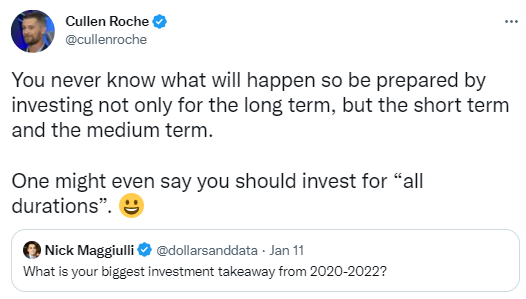Here are some things I think I am thinking about:
1) The 3 Most Important Charts Today
We posted a new 3 Minute Macro video about the three most important investing charts today. I discuss last week’s employment report and why it changed market sentiment so substantially.
Long story short – falling wages reduce the odds of a 1970’s style outcome. I’ve been saying that for the last few months, but the data is really starting to confirm that view. Yesterday’s update to the Atlanta Fed wage tracker also confirmed this.
On the other hand, there was some worrisome data in the employment report, including the fall in temp help and hours worked. These would typically be the leading indicators of a softening labor market as employees first move to reduce hours and temp workers before laying off more permanent employees.
So while the 1970s scenario looks less likely, the hard landing scenario is not off the table.
This all leads me to believe that the Fed will move to 5% and then sit tight for the remainder of the year as they reassess things.
2) The Biggest Lesson from the Last 3 Years
I think we all learned a lot about ourselves during the pandemic. Maybe more than we wanted to learn. But as it pertains to money – the biggest lesson for me was the sheer uncertainty of the future. I think a lot of us invest thinking the future will be more certain than we expect. And then something really unusual happens and we start to question what we’re doing. As Morgan Housel likes to say – “risk is what you don’t see”.
So I loved this question from Nick Maggiulli about the biggest lesson during the pandemic. My big lesson was the third big epiphany I discussed previously, which is the importance of diversifying across time. Modern Portfolio Theory has a lot of great lessons about how to properly construct a portfolio. But one thing it doesn’t do is apply the concept of time to our portfolios. So most of us will run backtests and slap together the portfolio that we think has the best forward looking risk adjusted returns without any real concept of how that portfolio applies to helping us navigate time. And time is the most important factor in all of this. If you’re 100% stocks or even 100% bonds during a year like 2022 and you need liquidity then repeating “stocks/bonds for the long run” to yourself is pretty worthless because you don’t have a long-term for all that money. You need liquidity. You needed a shorter duration asset to match your liquidity needs. This, in my opinion, is the #1 reason why people have trouble sticking with specific investment plans – they have no idea what the proper time horizon for their portfolio is and they’re generally diversified across a mix of assets that they can’t apply to specific time horizons in a clearly structured manner.

I always liked the idea that risk is not having money when you need it. So yes, risk is what you don’t see, but you’ll never see the black swans coming. But you can implement an all weather style asset allocation (such as this one) that prepares you for the black swan no matter what. And to me the essential ingredient there is allocating not just across diverse assets, but also diversifying across time so that you own assets across all durations that give you certainty about specific liability needs in the future.
3) Silly Debates
There are two really silly debates going on right now. The first is the meaningless debt ceiling. And the second is the endless recession debate.
First, the debt ceiling is silly in and of itself. I’ve discussed this in some detail lately, but it’s amazing that we keep doing this to ourselves. We keep threatening to default on ourselves over a self imposed constraint that doesn’t actually constrain anything. We have a debt ceiling in place where we just keep raising the ceiling every few years. What is the purpose of a debt ceiling that doesn’t actually keep anything enclosed? It’s not constraining debt. It’s not constraining anything. It’s just creating bond market risk for no good reason. What is the point?
I also keep seeing people debate whether a recession is coming or not. I don’t like this thinking because it gives people the impression that the economy is like an on/off switch. As if we just switch into a recession. In reality the economy is more like a dimmer switch. It slowly slides between growth and contraction. Most of the time the dimmer is sliding up or slightly on. But it can slowly dim to the point where the light turns off or dims enough that you can’t see.
Why does it matter? Well, a lot of people in finance and politics think in these strictly binary terms. You’re either in or out and the economy is either on or off. But the reality is that we live life in the grey area and thinking about the future isn’t just a binary decision. It’s a range of changing outcomes that require us to think in probabilistic terms.
That’s all for today. Have a great weekend.
Mr. Roche is the Founder and Chief Investment Officer of Discipline Funds.Discipline Funds is a low fee financial advisory firm with a focus on helping people be more disciplined with their finances.
He is also the author of Pragmatic Capitalism: What Every Investor Needs to Understand About Money and Finance, Understanding the Modern Monetary System and Understanding Modern Portfolio Construction.

